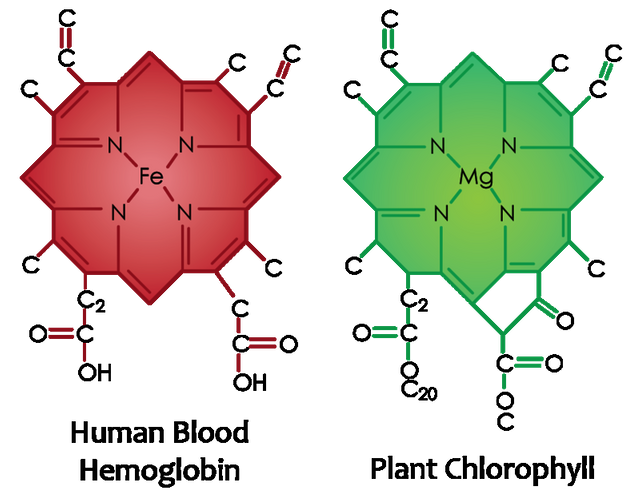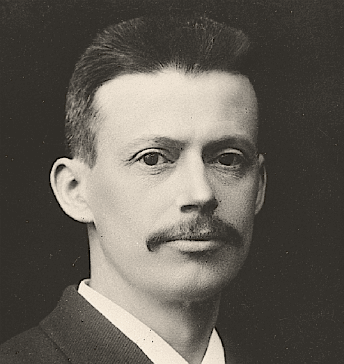A Very Brief History of Red Light

http://www.resonantfm.com/a-very-brief-history-of-red-light/
The Old Gods had many incarnations across cultures and civilisations, at the centre of many of these religious systems was the major source of light and life on Earth – The Sun. Tracking the movements of The Sun is necessary to track seasons, to plan food crops and other season dependent necessities. Humans have been acutely aware of this elements effect on plant life for many generations, through simple and necessary observations . Many of the ancient structures classified in the textbooks as funerary monuments and religious sites have very clear solar properties embedded in the central structures, with satellite “temples” often tracking lesser sources of light across the ancient sky.
Tracking The Sun, literally and through records, serves as a method of recording and predicting the amount of light and total solar radiation over time, this variable energetic output is most obviously of significance to food availability and weather conditions, important life and death factors which take on even more significance outside of the equatorial regions .

Plant growth and differentiation under the influence of light.
Jan Van Helmont hypothesised in the mid 1700’s that much of the mass of a growing plant must come from water, as the difference in the soil mass over time could not explain the increase in plant mass. He was partially correct as carbon dioxide also made up a large part of the increase in the plant mass. Joseph Priestley and Jan Ingenhousz performed experiments with plants and animals over the next century which led to the understanding that light had a causal role in plant metabolism, observations that led to the understanding of photosynthesis, the process by which plants use the suns energy to synthesize sugars and starches from water and carbon dioxide.
The plant photo-acceptor chlorophyll, which catalyses photosynthesis under the influence of specific bands of light is pretty well known, however there are other biological photoacceptors less well known in the plant and animal kingdoms. For example, carotenoids in plant species, hemoglobin, myoglobin, rhodopsin and cytochrome in animals. The late 1900’s and early 20th century saw many observations on the effects of light on animal life, including Man. Many Solaria, modern Sun Temples of sorts were constructed, this time not tracking the movements of celestial generators and energy cycles but the effects of light exposure on animal, and particularly Human life.
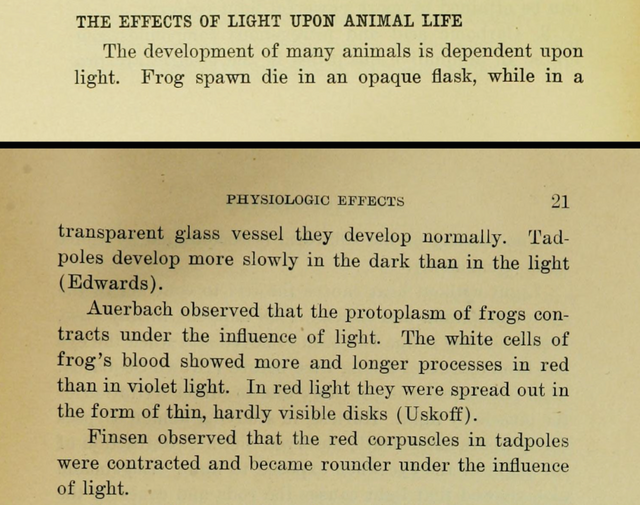
John Kellog – Light Therapeutics – 1910
Arnold Rikli developed helio-hydroscopic treatment centres in Slovenia in the 1850’s and inspired further solar treatment centres and methods, notably with August Rollier and Dr Albert Monteuuis. These places were centres medicine and thought, rational and mystical, particularly in certain sections of European Society. In 1922 Sir Henry Gauvain, a leading heliotherapist in Great Britain reflected on the dual nature of heliotherapy, knowledge of the destructive capacity of the Suns spectrum perhaps led to a decrease in it’s popularity.
“like a good champagne. It invigorates and stimulates; indulged in to excess, it intoxicates and poisons”
~Sir Henry Gauvin~
Still into the 1930s and beyond many hospitals Charing Cross Hospital in London used ‘sun-lamps’ to treat circulatory diseases, anaemia, varicose veins, heart disease and degenerative disorders, though perhaps the birth of artificial light may have spurred more interest in it’s usefulness.The development of artificial light took over one hundred years from the voltaic pile to the familiar incandescent bulb, which had it’s first incarnation with Tungsten filament in 1910 by William David Coolidge of General Electric. This development was a further catalyst in the exploration of light on animal physiology, pivotal in these discoveries were John Kellog and Niels Ryberg Finsen.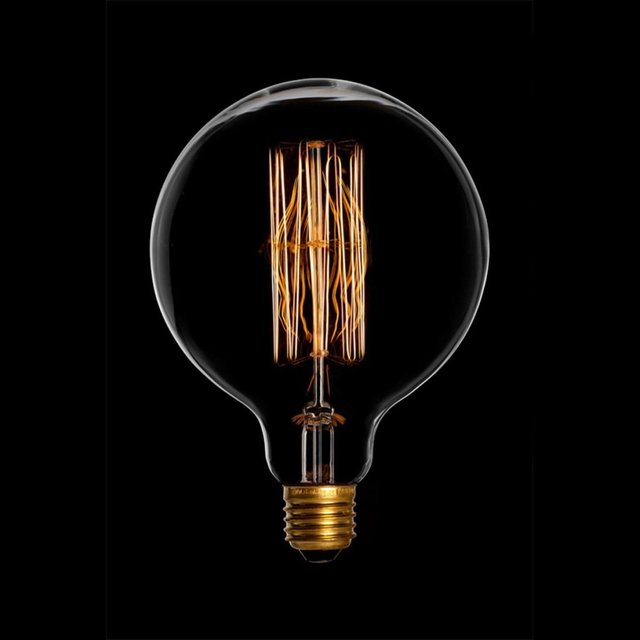
5-1 Edison bulb
Finsen suffered from Niemann Pick disease, which inspired him to sunbathe and investigate the effects of light on living things. As a result, Finsen is best known for his theory of phototherapy, in which certain wavelengths of light can have beneficial medical effects. His most notable writings were “On the effects of light on the skin“, published in 1893 and “The use of concentrated chemical light rays in medicine“, published in 1896.
He gave the following account of his work:
“My disease has played a very great role for my whole development… The disease was responsible for my starting investigations on light: I suffered from anaemia and tiredness, and since I lived in a house facing the north, I began to believe that I might be helped if I received more sun. I have spent as much time as possible in its rays. As an enthusiastic medical man I was of course interested to know what benefit the sun really gave. I considered it from the physiological point of view but got no answer. I drew the conclusion that I was right and the physiology wrong. From this time (about 1888) I collected all possible observations about animals seeking the sun, and my conviction that the sun had a useful and important effect on the organism (especially the blood?) became stronger and stronger. What this useful effect really was, I could not find; I have been working for this goal ever since but have not been able to find exactly what I have been seeking, though we have gone somewhat forward.”
Finsen pioneered the use of red light in 1893 for the treatment of smallpox; this treatment, by protecting the skin against harmful light rays, was believed to facilitate the healing of the skin lesions and prevent the appearance of scars which are often the sequel to this disease. Finsen won the Nobel Prize in Physiology in 1903 for his work on phototherapy.
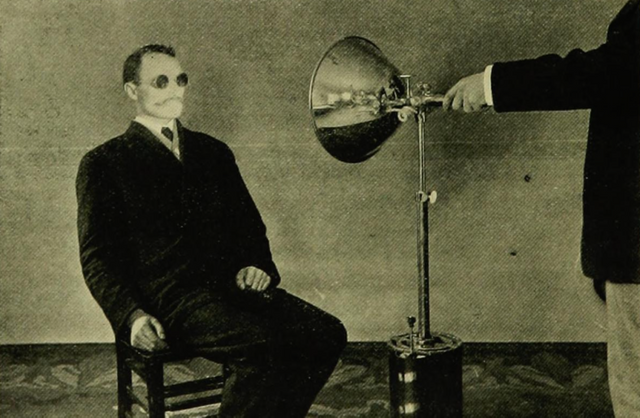
Arc Light to the Face. Show you mean business.
John Harvey Kellogg, 1852-1943 was an American medical doctor in Battle Creek, Michigan known for the invention of the breakfast cereal known as Corn Flakes with his brother, Will. He was also a pioneer of light therapy and in 1910 publication of “Light Therapy: A Practical Manual of Phototherapy for the Student and the Practitioner. He was associated with Finsen and detailed many treatments using light, natural and artificial. Many of his observations reference Finsen’s, the differentiation of effects of various wavelength bands, specifically the antagonism to a large degree between blue/UV and red/near infrared (NIR). Kellogg describes treatment for many ailments such as diabetes, obesity, depression, influenza, fatigue and insomnia, often using heat and cold along with phototherapy and detailing many devices such as the Arc Light and the Electric Light Bath.
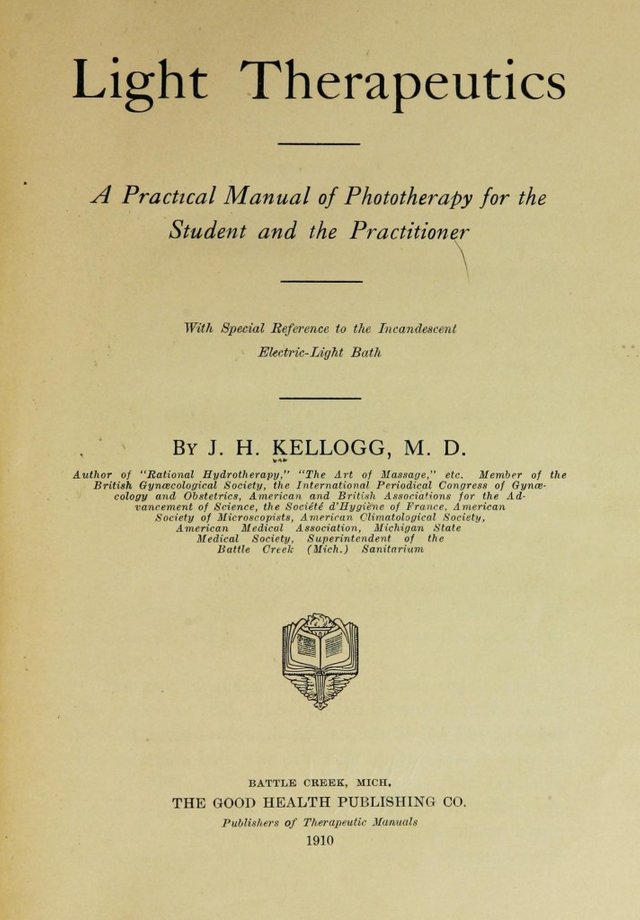
Light Therapeutics – John Kellog
Observations on light, it’s systemic effects and the differentiation of these effects with respect to wavelength were made and then consigned to the memory hole in Academia for many decades. Perhaps if some intellectual monopoly on wavelength were granted by the creators innovation and wealth the field may have been able to “compete” with the vested interests.
“Visible light, the textbooks said, was not “chemically active,” and so couldn’t possibly affect animals’ cells. In animals, coloration was seen mainly as decoration and disguise, rather than as a functional part of their biochemistry.
(Chemically, the meaning of “a pigment” is that it’s a chemical which selectively absorbs radiation. Old observations such as Warburg’s, that visible light can restore the activity of the “respiratory pigments,” showed without doubt that visible light is biochemically active. By the 1960s, several studies had been published showing the inhibition of respiratory enzymes by blue light, and their activation by red light. The problem to be explained is why the science culture simply couldn’t accept crucial facts of that sort.)”
~Ray Peat~
Aging Eyes, Infant Eyes, and Excitable Tissues
http://raypeat.com/articles/articles/aging-eyes.shtml
The objective effects of light on animal life is enormous however. Many viable mechanisms have been hypothesised and some have been partially tested. Kellog described experiments in 1910 detailing the change in animal metabolism under the influence of light by measuring carbon dioxide.
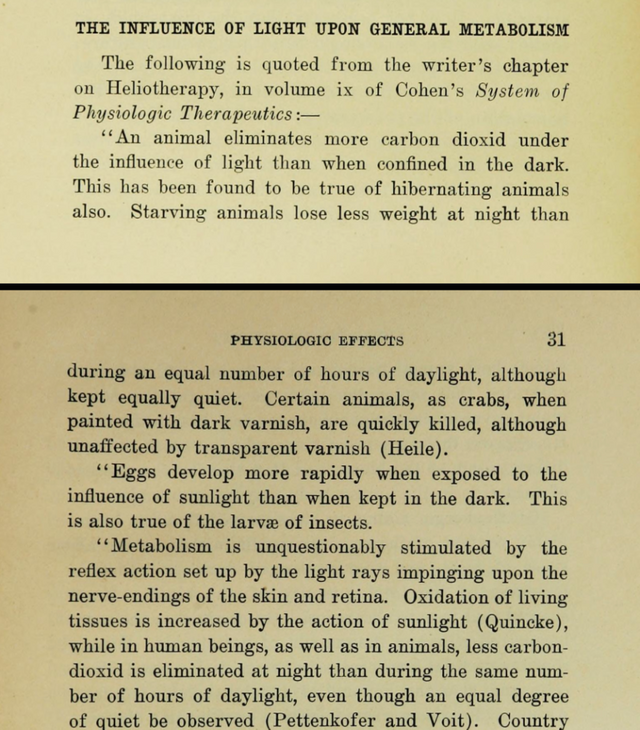
John Kellog – The Influence of Light
One mechanism proposed to explain the pro-metabolic effect of light, specifically red/NIR is the role of the respiratory enzyme Cytochrome C Oxidase (CCO). There are in fact a number of theories regarding light’s interaction with this respiratory enzyme. The “engine of life”, the mitochondria, contains CCO, it is the final donor in the electron transport chain, a series of reactions which occur to generate cellular energy, the final reaction involves CCO and this is necessary for efficient energy production (Oxidative phosphorylation) and this determines the health of the organism to a large degree. The organism produces Nitric Oxide (NO) under stress for a number of reasons. NO can however become bound to CCO, making proper energetic metabolism impossible in the instance where it occurs due to NO blocking oxygen in the CCO enzyme. Inefficient and primitive methods of generating cellular energy such as glycolysis are then only possible in that mitochondria.
Under stress a cell will produce NO under NO synthase, this blocks oxygen from CCO down regulating cellular respiration and the energy storing ATP. Low Lever Laser Therapy (LLLT) is a description of the therapeutic use of red and near infrared light (600-100nm) within specific narrow bands, virtually monochromatic, at relatively low intensities ( generally 5mW/cm2 to 750mW/cm2. LLLT releases or photodissociates NO from CCO thereby allowing oxygen use and unhindered cellular respiration. LLLT then through it’s action on NO may increase the energetic capacity of the cell and therefore the potential to do all “work” in the organism, while at the same time possibly creating a beneficial hormetic effect from reactive oxygen species (ROS). The increase in ROS may also lead to up regulation of stimulatory and protective genes. CCO and NO may be involved in the immediate pain relief experienced in some LLLT treatments.
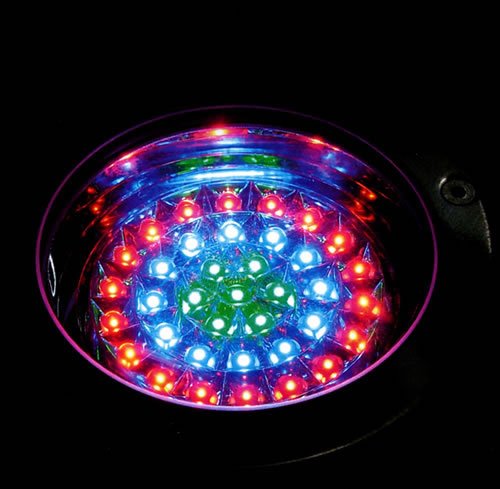
LED Technology – A Double Edged Sword?
Nitric oxide may also be released from nitrosothiols, hemoglobin or myoglobin under the influence of of red and near infrared. Increase in cells calcium levels could also increase NO detection due to it increasing nitric oxide synthase. Tiina I. Karu studied LLLT in regard to CCO and identified likely absorption peaks of CCO which seem to overlap with increased effects of LLLT at 620, 680 , 760 and 820nm (indicating a potential causal mechanism). Cytochrome c oxidase is a copper enzyme and it is thought that the peaks relate to the different copper centres of the molecule relevant to their reduced or oxidised status.
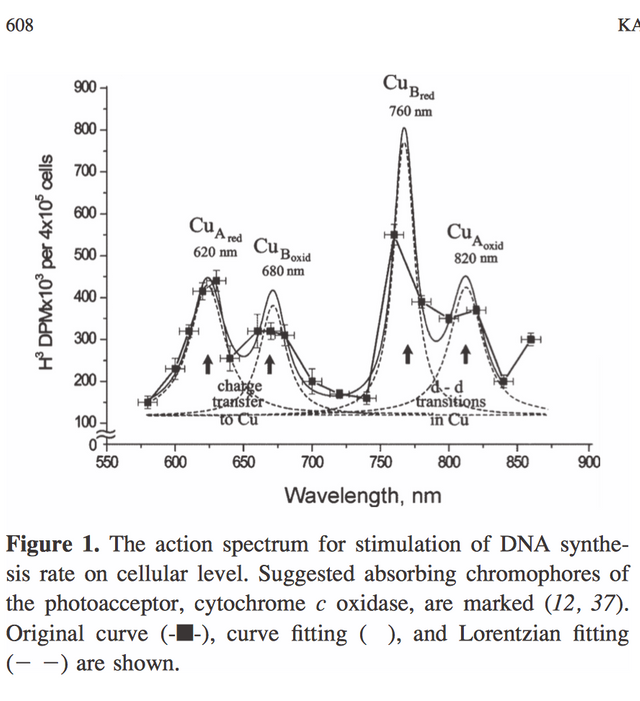
CCO action spectrum in the red and NIR.
Multiple Roles of Cytochrome c Oxidase in Mammalian Cells Under Action of Red and IR-A Radiation
Karu discusses a potential retrograde signalling mechanism of the relevant light spectrum within the cell. As increased DNA synthesis is shown and this occurs in the nucleus, away from the mitochondria and the cytochrome c oxidase photoacceptor, the signalling is inferred, though the study of this is described as “fragmentary”. UV does not elicit the same behaviour within the cell. A 628nm light was shown in increase DNA and RNA synthesis rates and up-regulate over 100 genes.
“When I moved from Mexico, first to Montana and then to Oregon in 1966, I became very conscious of how light affects the hormones and the health. (For example, in Montana I experienced an interesting springtime shedding of body hair.) Many people who came to cloudy Eugene to study, and who often lived in cheap basement apartments, would develop chronic health problems within a few months. Women who had been healthy when they arrived would often develop premenstrual syndrome or arthritis or colitis during their first winter in Eugene. The absence of bright light would create a progesterone deficiency, and would leave estrogen and prolactin unopposed. Beginning in 1966, I started calling the syndrome “winter sickness,” but over the next few years, because of the prominence of the premenstrual syndrome and fertility problems in these seasonally exacerbated disorders, I began calling it the pathology of estrogen dominance. In the endocrinology classes I taught at the National College of Naturopathic Medicine, I emphasized the importance of light, and suggested that medicine could be reorganized around these estrogen-related processes.”
~Ray Peat~
Treatments have evolved from sunlight through incandescent light and from the 1960s experiments were conducted with Lasers, beginning with Endre Mesters accidental discovery that low energy monochromatic red light elicited increased hair growth rate in rodents. More recently LED technology has become so efficient and cheap that in most instances it has become a better solution. Technological advances and ideological motivations have also led to a lowering of red/NIR exposure from artificial light in many regions due to the forced adoption of high efficiency efficiency bulbs, such as CFL, which produce much more blue/UV compared to the relatively high red/NIR incandescents. The potential for unintended negative consequences of politically motivated , authoritarian, social engineering increases exponentially with technology.
RPF – Light induced Parkinsons Disease in Rodent Model
https://raypeatforum.com/community/threads/fluorescent-light-kills-dopamine-in-the-brain.8212/
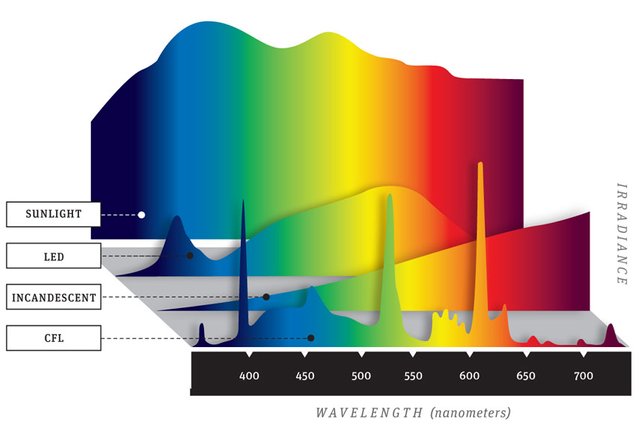
Red/NIR and Blue output of bulbs.
Some of the conditions that may be indicated in (red/NIR) light treatment include; Autoimmune thyroiditis, Acne, Achilles tendinitis, Arthritis, Alopecia Areata, Alzheimer’s, Angina pectoris, Aphthous stomatitis, Back and neck pain, Burns recovery, Bone density, Candida, Carpal tunnel syndrome, Chemotherapy-induced oral mucositis, Cholesterol regulation, Chronic myofascial pain in the neck, Connective tissue/joint injury, Depression, Dry mouth, Dysmenorrea, Edema, Fibromyalgia, Gingivitis, Hand-foot-and-mouth disease, Heart attack (recovery and likely prevention), Herpes labialis, Ischemia, Fat loss, Fracture (recovery), Lateral epicondylitis, Liver regeneration, Lowering inflammation (PGE(2), Cox 2, IL-1b, TNF, neutrophil cell influx and oxidative stress), Lung inflammation, Lymphedema, Macular degeneration, Migraine (some types), Male and female androgenetic alopecia, Muscle growth, Myopia, Neuropathy, Onychomycosis, Orthodontic pain, Oral Lichen Planus, Orofacial myofunctional conditions, Parkinsons, Photoaged skin, Psoriasis, Pressure ulcer, Raynaud’s phenomenon, Recovery from third molar extraction, Restless legs syndrome, Spinal cord injury, Stroke, Skin ulcers, Sleep quality, Tinnitus, Tooth regrowth, Testosterone levels, Traumatic brain injuries, UVB-induced erythema, Wound healing.
The proposed and likely mechanisms of these wavelengths point toward indicating potential usefulness in all metabolic disorders, inflammatory conditions, “auto-immune” diseases, endocrine disorders and many degenerative conditions. I will examine some aspects of this in the near future, however there are many references online, though many are dense scientific papers. Here are a list of some good articles providing some overview along with some of the important factors for consideration and most likely mechanisms.
http://www.functionalps.com/blog/2011/09/30/light-is-right/
http://valtsus.blogspot.ie/2015/05/the-therapeutic-effects-of-red-and-near.html
http://heelspurs.com/led.html
http://www.ncbi.nlm.nih.gov/pubmed/22045511
http://www.isan.troitsk.ru/dls/publ3/344.pdf
http://www.ncbi.nlm.nih.gov/pubmed/22461763
http://waltza.co.za/wp-content/uploads/2012/08/Dose_table_780-860nm_for_Low_Level_Laser_Therapy_WALT-2010.pdf
http://waltza.co.za/wp-content/uploads/2012/08/Dose_table_904nm_for_Low_Level_Laser_Therapy_WALT-2010.pdf
